|
|
|
Sort Order |
|
|
|
Items / Page
|
|
|
|
|
|
|
| Srl | Item |
| 1 |
ID:
067298
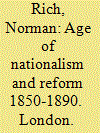

|
|
|
|
|
| Publication |
London, WeidenFeld and Nicolson, 1970.
|
| Description |
xii, 212p.Hbk
|
| Standard Number |
0297004182
|
|
|
|
|
|
|
|
|
|
|
|
Copies: C:1/I:0,R:0,Q:0
Circulation
| Accession# | Call# | Current Location | Status | Policy | Location |
| 008320 | 940.28/RIC 008320 | Main | On Shelf | General | |
|
|
|
|
| 2 |
ID:
117475
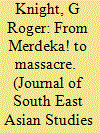

|
|
|
|
|
| Publication |
2012.
|
| Summary/Abstract |
Between 1945 and 1965, what may be broadly defined as the politics of sugar in Indonesia passed through several critical stages. The industrial manufacture of sugar had begun in the Netherlands Indies in the mid-nineteenth century, but after a slump during the 1930s Depression, the industry virtually went into abeyance during the Japanese Occupation (1942-45). After the war, the years of struggle for Merdeka! (freedom) also saw a partial revival of the industry, which continued through national revolution and independence (1949) through to an incremental nationalisation in the late 1950s. Developments in the sugar industry culminated in massacre, rather than merdeka, however. The campaign against the PKI (Indonesian Communist Party) which began in 1965 resulted in the murder of labour unionists and peasant activists associated with the sugar industry. This paper traces the course of events from Merdeka to massacre, focusing on the sugar industry of East Java's Brantas valley. Its themes, however, relate to the industry in Java as a whole, and the question of why the commodity production of sugar came to be so deeply embroiled in the politics of the new republic.
|
|
|
|
|
|
|
|
|
|
|
|
|
|
|
|
| 3 |
ID:
117476
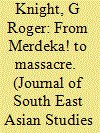

|
|
|
|
|
| Publication |
2012.
|
| Summary/Abstract |
Between 1945 and 1965, what may be broadly defined as the politics of sugar in Indonesia passed through several critical stages. The industrial manufacture of sugar had begun in the Netherlands Indies in the mid-nineteenth century, but after a slump during the 1930s Depression, the industry virtually went into abeyance during the Japanese Occupation (1942-45). After the war, the years of struggle for Merdeka! (freedom) also saw a partial revival of the industry, which continued through national revolution and independence (1949) through to an incremental nationalisation in the late 1950s. Developments in the sugar industry culminated in massacre, rather than merdeka, however. The campaign against the PKI (Indonesian Communist Party) which began in 1965 resulted in the murder of labour unionists and peasant activists associated with the sugar industry. This paper traces the course of events from Merdeka to massacre, focusing on the sugar industry of East Java's Brantas valley. Its themes, however, relate to the industry in Java as a whole, and the question of why the commodity production of sugar came to be so deeply embroiled in the politics of the new republic.
|
|
|
|
|
|
|
|
|
|
|
|
|
|
|
|
| 4 |
ID:
050111
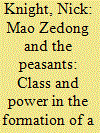

|
|
|
|
|
| Publication |
Jan-March 2004.
|
|
|
|
|
|
|
|
|
|
|
|
|
|
|
|
| 5 |
ID:
042933


|
|
|
|
|
| Publication |
London, VERSO, 1984.
|
| Description |
xvi, 385p.pbk
|
| Standard Number |
086091089X
|
|
|
|
|
|
|
|
|
|
|
|
Copies: C:1/I:0,R:0,Q:0
Circulation
| Accession# | Call# | Current Location | Status | Policy | Location |
| 025384 | 984.052/DUN 025384 | Main | On Shelf | General | |
|
|
|
|
| 6 |
ID:
077518


|
|
|
| 7 |
ID:
102942


|
|
|
|
|
| Publication |
2011.
|
| Summary/Abstract |
This work examines U.S-Bolivian relations in the years leading up to Víctor Paz Estenssoro's National Revolution in 1952. Harry S. Truman's diplomats and national security planners sought to secure scarce tin for stockpiling and domestic consumption during the early Cold War, but unintentionally helped to destabilize three pro-U.S. Bolivian governments. U.S. efforts to drive down the price of tin, led by Reconstruction Finance Corporation (RFC) chief Stuart Symington and Senator Lyndon B. Johnson but often opposed by the State Department, exacerbated Bolivian economic problems and created a climate in which Paz Estenssoro and his Movimiento Nacionalista Revolucionario could flourish. Although Truman did eventually intervene personally to resolve the standoff between the RFC and the Bolivians in the days before the National Revolution, he acted too late to avert one of the most significant Latin American social revolutions of the twentieth century.
|
|
|
|
|
|
|
|
|
|
|
|
|
|
|
|
| 8 |
ID:
115032
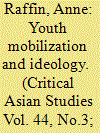

|
|
|
|
|
| Publication |
2012.
|
| Summary/Abstract |
This article, based on archival data, tracks the evolution of youth mobilization in Cambodia from the Vichy French colonial National Revolution duringWorld War II through the country's revolutionary implosion under Pol Pot in 1979. Successive regimes relied on young people to consolidate power and protect the nation from external and internal threats. An overarching ideology of agrarianism structured the political beliefs of the leaders and committed cadres of these youth corps, ranging from an ideology of civic agrarianism under colonial officials and Sihanouk, to Lon Nol's military agrarianism, and finally to the Pol Pot regime's mobilization of youth via an ideology of revolutionary agrarianism that aimed to create a utopian agrarian nation. While the lives of young Cambodians had traditionally been shaped by two institutions, the family and the sangha, the advent of state-sponsored youth organizations in the mid twentieth century provided a new space for young people beyond the family and existing religious organizations. In this respect, the author argues, the Cambodian youth corps was part of modernity. In spite of this development, those in power continued to mobilize young people via ideologies based on agrarian values, an idealization of the past, and the desire to create a "new man." The state's instrumental use of youth organizations during this period can thus be seen as a type of reactionary modernism.
|
|
|
|
|
|
|
|
|
|
|
|
|
|
|
|
|
|
|
|
|